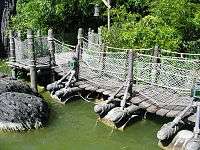Adventure Isle (Disneyland Paris)
Adventure Isle is an artificial island in the center of Adventureland at Disneyland Paris. It opened with the park in 1992.
| Adventure Isle | |
|---|---|
| Disneyland Park (Paris) | |
| Area | Adventureland |
| Status | Operating |
| Opening date | April 12, 1992 |
| General statistics | |
| Attraction type | Walkthrough |
| Designer | Walt Disney Imagineering |
| Theme | Adventure |
Adventure Isle

When creating Disneyland Paris, Imagineers decided Big Thunder Mountain would be the centerpiece of Frontierland. As such, finding a new spot of land for Tom Sawyer Island became mandatory. In the end, Imagineers decided that an Adventureland-themed island, complete with the Swiss Family Treehouse, would fit as a centerpiece in Adventureland. Adventure Isle is divided into two smaller islands.
Northern Island
This island is home to the Swiss Family Treehouse. In this park, the attraction was given a more detailed environment. For example, under the tree guests can explore Le Ventre de la Terre (The Earth's Belly), a network of dark caves filled with roots from the tree above, which the Swiss Family uses as cellar. Also, in La Mer des Bretteurs (The Swordmen Sea) nearby lies the wrecked ship the castaways originally used.
In this part, French is used as the main language. An elevated wooden bridge and another floating one link this island to the Southern one.
Southern Island
This is a more rocky landscape, featuring Captain Hook's Pirate Ship moored near Skull Rock. A small playground area lies near the ship, called La Plage des Pirates (Pirates Beach).
A huge mountain, known as Spyglass Hill, stands on this part, and is mainly composed of mazes and caves. A treasure is hidden inside. Some caves refer to the Disney movie Treasure Island (one is called Ben Gunn's Cave).
Here, English is the main language.
Trivia
- In order to create a realistic Spyglass Hill, Imagineers went searching for actual rocks in storehouses around France and bought them, much to the owner's surprise.